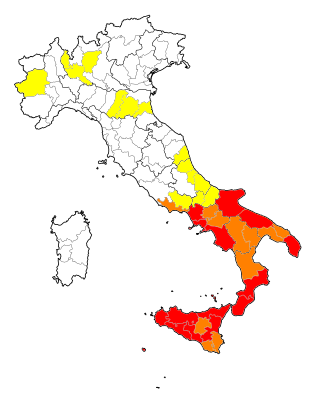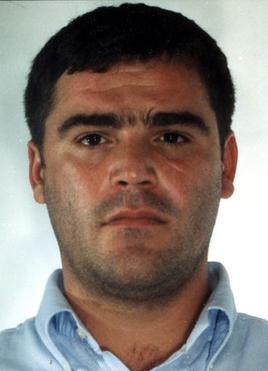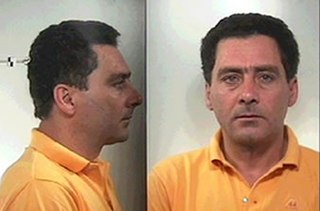The Camorra is an Italian Mafia-type criminal organization and criminal society originating in the region of Campania. It is one of the oldest and largest criminal organizations in Italy, dating to the 17th century. The Camorra's organizational structure is divided into individual groups called "clans". Every capo or "boss" is the head of a clan, in which there may be tens or hundreds of affiliates, depending on the clan's power and structure. The Camorra's main businesses are drug trafficking, racketeering, counterfeiting, and money laundering. It is also not unusual for Camorra clans to infiltrate the politics of their respective areas.

Criminal organizations have been prevalent in Italy, especially in the southern part of the country, for centuries and have affected the social and economic life of many Italian regions. There are major native mafia-like organizations that are heavily active in Italy. The most powerful of these organizations are the 'Ndrangheta from Calabria, the Cosa Nostra from Sicily, and the Camorra from Campania.

Roberto Saviano is an Italian writer, essayist, journalist, and screenwriter. In his writings, including articles and his book Gomorrah, he uses literature and investigative reporting to tell of the economic reality of the territory and business of organized crime in Italy, in particular the Camorra crime syndicate, and of organized crime more generally.
The Di Lauro clan is an Italian crime clan, part of the Camorra in Naples. The clan operates in the neighbourhoods of Secondigliano, Scampìa, Miano, Marianella, Piscinola, and in the adjacent municipalities of Casavatore, Melito, Arzano, Villaricca and Mugnano. At its peak, between the mid-1990s and the early 2000s, the organization was earning more than €500,000 a day from the sale of drugs alone, making Secondigliano the largest open-air drug market in Europe. The founder of the clan is Paolo Di Lauro, from Via Cupa dell'Arco, in Secondigliano.
The Nuova Famiglia was an Italian Camorra confederation created in the 1970s and headed by the most powerful Camorra bosses of the time, Carmine Alfieri, the Nuvoletta brothers, Michele Zaza, Luigi Giuliano and Antonio Bardellino, to face Raffaele Cutolo's Nuova Camorra Organizzata, and affiliated with the Sicilian Mafia.

Carmine Alfieri is an Italian Camorra boss, who rose from Piazzolla di Nola to become one of the most powerful members of Neapolitan Camorra in the 1980s. As boss of the Alfieri clan, he was one of the most influential and powerful Camorra bosses from 1984 until his arrest in 1992. Alfieri's nickname is 'o 'ntufato, the angry one, thanks to the dissatisfied, angry sneer he wears constantly.

Francesco Schiavone is a member of the Camorra, the Caserta organized crime syndicate, and the head of the Casalesi clan from Casal di Principe in the province of Caserta. He has been dubbed Sandokan after a popular 1970s television series starring Kabir Bedi because of his thick, dark beard.

Antonio Bardellino was a powerful Camorrista and boss of the Casalesi clan, having a prominent role in the organized crime in the province of Caserta during the 1980s. He was one of the last of the old-style Camorra godfathers.

The Casalesi clan is a clan within the Camorra, an Italian criminal organization, operating from San Cipriano d'Aversa in the province of Caserta. Formed by Antonio Bardellino, it is a confederation of clans in the Caserta area. The Casalesi clan is believed to be one of the most powerful groups within the Camorra, specialising in construction and keeping a lower profile than clans that focus on drug dealing.

Antonio Iovine is a powerful Italian Camorrista and one of the bosses of the Casalesi clan from Casal di Principe in the province of Caserta between Naples and Lazio. His nickname is 'o ninno, because of his baby face when he was made a capo at a very young age.

Francesco Bidognetti is a powerful Italian Camorrista. He is the chief lieutenant of Francesco Schiavone, boss of the Casalesi clan from Casal di Principe in the province of Caserta, and head of the Bidognetti clan, one of the five clans which make up the Casalesi. He is known as "'Cicciott' 'e Mezzanotte'".

The Spartacus Trial was a series of criminal trials, each specifically directed against the activities of the powerful Casalesi clan of the Camorra. The trial was opened at the Corte d'Assise of Santa Maria Capua Vetere in Caserta. It was named after the historical gladiator, Spartacus. The trial was initially chaired by its president, Catello Marano on 1 July 1998. It continued just over ten years, until its final verdict was eventually read on 19 June 2008.

Giuseppe Setola is an Italian Camorrista and former boss of the Casalesi clan from Caserta. Since 2008, he was included on the list most wanted fugitives in Italy, until his arrest on January 14, 2009, in Mignano Monte Lungo. Setola allegedly headed a squad of killers, and was said to have ordered or carried out 18 murders throughout the latter half of 2008. Police began a massive manhunt against Setola in response to the murders of six West African immigrants in Castel Volturno.
Carmine Schiavone was a former member of the Casalesi clan from Casal di Principe in the province of Caserta. He was a cousin of former Camorra superboss Francesco Schiavone and became a pentito collaborating with Italian Justice. He was the chief witness against the Casalesi clan during the Spartacus Maxi trial that culminated in sixteen senior Casalesi figures being sentenced to life imprisonment, among them Francesco Bidognetti, Michele Zagaria and Antonio Iovine. After living in the Witness Protection Program for some years, Schiavione retired to live in the province of Viterbo, with his wife and two children.

Raffaele Diana is an Italian Camorrista and senior boss of the Casalesi clan from Caserta. His nickname is Rafilotto.

Mario Caterino is an Italian Camorrista and member in the Casalesi clan from Casal di Principe in the province of Caserta between Naples and Salerno. He was on the "most wanted list" of the Italian ministry of the Interior since 2005, for murder and membership in the Camorra, until he was arrested on 2 May 2011 in Casal di Principe.
Nicola Panaro, is an Italian Camorrista and member in the Casalesi clan from Casal di Principe in the province of Caserta between Naples and Salerno. He has been on the "most wanted list" of the Italian ministry of the Interior since 2003 until his arrest in April 2010. Convicted for extortion and membership in the Camorra, he has yet to serve a prison sentence of nine years and four months.
Ernesto Fazzalari is an Italian criminal and a member of the 'Ndrangheta, a Mafia-type organisation in Calabria.
The Mazzarella clan is a Campanian Camorra clan operating in the city of Naples. The clan is historically considered one of the most powerful groups of the Camorra.










